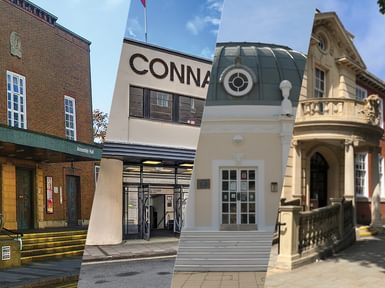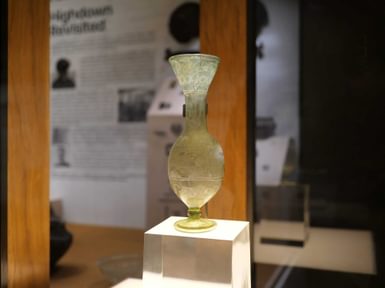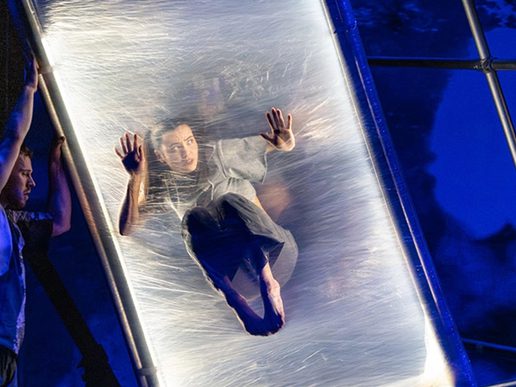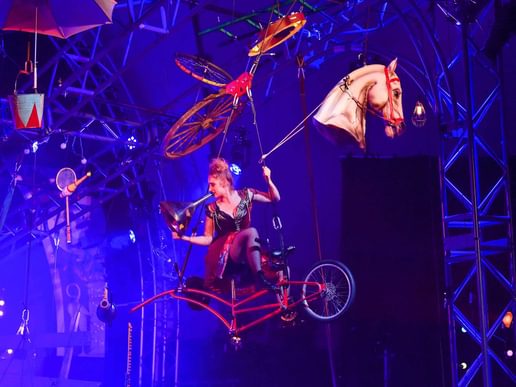
Worthing Theatres and Museum (WTM) brings together four unique and much-loved venues:
- Connaught Theatre – home to live theatre, comedy, and the latest films
- Pavilion Theatre – a beautiful venue at the end of the pier for shows, music and dance
- Assembly Hall – known for world-class acoustics and live classical concerts
- Worthing Museum – filled with art, fashion, archaeology, and stories from the town’s past
Together, these venues offer something for everyone—from blockbuster films and family shows to orchestral performances and inspiring exhibitions. Whether you're enjoying a night out, discovering local history, or seeing a new play, WTM is here to entertain, inspire and bring people together.
Each venue has an exciting story. Scroll down to learn more about its history and what makes it so special today.

Connaught Theatre
From early cinema to top-class live theatre, the Connaught has been at the heart of Worthing’s cultural life for over 100 years.
The Connaught Theatre began life in 1914 as a cinema called the Picturedrome. Next door, the Connaught Hall was built in 1916 as live entertainment became more popular.
By the 1930s, the old cinema had been transformed into the New Connaught Theatre, a stylish art deco venue that opened in 1935. On its first night, more than 5,000 people tried to get one of the 920 seats!
Many famous actors, including Patricia Routledge, Christopher Lee, David Suchet, and Roger Moore, began their careers here. Writers like Alan Ayckbourn and Harold Pinter also started on this stage.
The theatre has continued to grow. A lift was installed in 2007 to make it more accessible. In 2010, new cinema technology was added, and in 2017, the smaller Connaught Studio was fully refurbished. Today, the venue hosts theatre, film, comedy, and family shows all year round.
Pavilion Theatre
Set at the end of Worthing’s historic pier, the Pavilion Theatre has been entertaining audiences since 1926.
The Pavilion Theatre, opened in 1926, was inspired by the grand concert halls of Europe. It originally hosted the town’s municipal orchestra, plays, comedy, and music shows.
After a short closure during World War II, the Pavilion reopened in 1942 as a garrison theatre and continued entertaining the public and military alike. Since then, it’s welcomed stars like Ken Dodd, Julian Clary, Mickey Rooney, and many more.
The venue is flexible and unique. It has a sprung dance floor hidden beneath the carpets, perfect for ballet, circus, and ballroom events. The ornate proscenium arch above the stage features images of the nine muses from Greek mythology.
Today, the Pavilion hosts comedy, musicals, live music, and dance in a beautiful seafront setting.
Assembly Hall
The Assembly Hall is known for its world-class acoustics and various live performances.
The Assembly Hall was given to the town in 1934 by Alderman Denton and has been a major venue ever since. It’s part of the Worthing Town Hall complex and is used for concerts, comedy, and community events.
The venue is best known for its exceptional acoustics. Sound engineers and musicians alike say it has some of the finest acoustics in the country. John Gibbons, conductor of the Worthing Symphony Orchestra, has even said it "boasts some of the finest acoustics in Europe."
It’s home to the Worthing Symphony Orchestra, the only professional orchestra in West Sussex. The venue also houses the UK’s largest Wurlitzer organ, which rises through the stage during performances.
Big names like David Bowie, The Who, and Motorhead have performed here, and it continues to be a key stage for classical music, rock, pop and comedy alike.
Worthing Museum
Explore art, archaeology and one of the UK’s biggest costume collections at Worthing Museum.
Worthing Museum opened in 1908 thanks to a gift from Dr Howard Nicholls, who donated his large collection of British birds. Andrew Carnegie and Alfred Cortis helped create a new library and museum building.
Early curators Marion Frost and Ethel Gerard helped shape the museum into a lively space for exhibitions, learning and collections. Their work laid the foundations for what the museum is today.
Over the years, the museum added galleries, a sculpture garden, and new spaces like the Norwood Gallery (1993) and the Twentieth Century Costume Gallery (1990). It’s home to one of the UK’s most significant costume collections, as well as archaeological finds, fine art, and historic objects.
Visitors can enjoy changing exhibitions, workshops, and family activities that help tell the story of Worthing and beyond.




